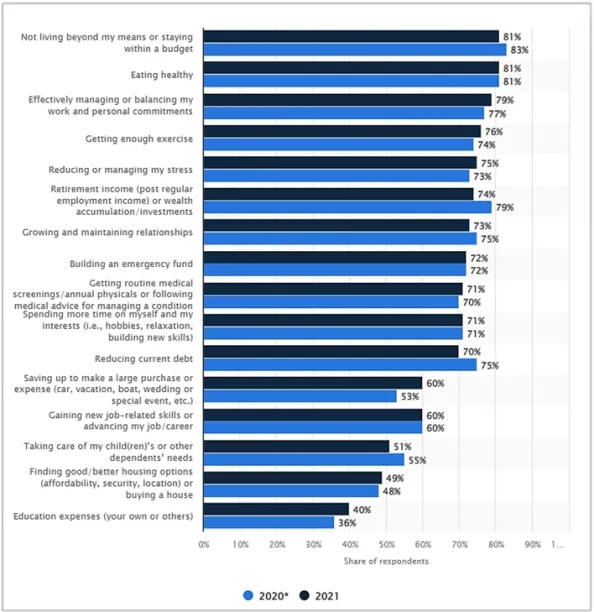6 Future of Work Trends in 2024
As our world evolves and changes, so does the way we work. Whether it’s due to the disruptions caused by global pandemics or the changing technological landscape, it significantly impacts how employees work. During the Covid-19 pandemic, occupations with higher risk, such as on-site customer service and leisure and travel, shifted to remote work, while others such as healthcare and grocery retail did not have that option. However, changes caused by technology and human behavior still touched them.
As the way we work changes, employers need to study these changes to better understand how they might impact their business. This article explores 6 trends in the future of work that employers should focus on working in the post-pandemic world and beyond.
1. Hybrid work
The pandemic affected occupations in different ways. Gartner states that the impact of the pandemic varies based on the level of physical proximity in workplaces (Figure 1). While some businesses have permanently shifted to a decentralized, remote work model, some remain on a centralized office work model, and some opt for a hybrid model.
Hybrid work is a rising trend based on a combination of remote and office work. Many employees prefer the flexibility of a hybrid structure and like having the choice. Employers are also planning to give more freedom to choose between remote and office work, and this trend will be observed during 2022 and beyond.
Source: Envoy
For a successful transition to a hybrid work model, employers need to focus on the following considerations:
- Create new procedures and policies or upgrade the existing ones to ensure alignment between the hybrid work model and the current policies.
- Upgrade legal information, including the terms and conditions of employee contracts, upgrade workplace addresses and review tax details.
- Provide training to employees regarding transitioning to a hybrid work lifestyle and achieving maximum value from it.
- Ensuring that the company is equipped with the right tools and technology to enable collaboration and communication in a hybrid work environment.
Some sources report that hybrid work is also causing employees extra exhaustion. Therefore before implementing hybrid in your workforce, employers need to consider how it might impact the employees.
Figure 1. Physical proximity score of different workplaces and occupations
2. Shifting focus from roles to skills
According to Gartner, in the post-pandemic world, the focus of employers will be shifting from “job roles which have a package of unrelated and different skills” to “specialized critical skills which cater to specific business needs and challenges”. This is mainly because companies are realizing that roles are more related to a place in the structural hierarchy of an organization whereas skills cater specifically to the business needs and challenges. As organizations move to more flat hierarchical structures, they will search for more specialized skills to tackle specific problems in the business.
Therefore, employers will now create new positions based on specific critical skills rather than hierarchical roles. Additionally, employers should also encourage existing employees to improve their critical skills to keep them from becoming obsolete. For 2022 and beyond, employees should also focus more on developing their specific skills to enhance their overall employability and better prepare themselves for this trend.
3. Digital transformation
The pandemic has significantly accelerated digital transformation, and companies are investing more in digital technologies like artificial intelligence (AI) and the internet of things (IoT). As a result, almost every company now requires digital skills from its existing and new employees, even in business-related roles. According to Gartner, the demand for digital skills, specifically in AI, RPA, and data science/analytics, has surged in non-IT companies’ business areas.
Another study by the World Economic Forum predicts that AI and automation will create 97 million new jobs by 2025. As digital takes over, another trend that will be prominent is the augmentation of the workforce and automation. Employees will be expected to work together with AI and automation technologies. This means that as repetitive and error-prone tasks are automated, employees will augment their abilities to provide human input where required. A few implications of AI augmentation include law automation, healthcare analytics, and retail.
For this trend, employees need to focus on improving their digital skills to better prepare themselves to work together with digital technology. From the employer’s perspective, they should not approach digital transformation as replacing humans with technology; instead, they should see it as a way of enhancing how people work.
Digital transformation can be a complex process. You can work with a digital transformation consultant to streamline this process and ensure success. Check out our sortable/filterable list of digital transformation consulting companies to find the fit that best suits your business needs.
4. Employee monitoring
According to Gartner, more employee analytics and monitoring will also be a prominent trend in 2022 and beyond. An increasing number of employers are investing in employee productivity monitoring and analytics technology. These tools also include remote work monitoring tools, which provide data to employers to improve employee behavior at home.
These tools can be considered as a violation of employee privacy or can be overwhelming for workers to be continuously monitored. However, HBR states that monitoring employees can also lead to improvements in employee engagement and well-being which can result in higher productivity.
As employers gather and use more employee data, they should consider the following points:
- Consider the privacy of employees and ethical factors
- Proceed with transparency and communicate the process with employees
- Clarify the intentions of collecting and using the data
To regulate employee monitoring, many governments are putting limitations on what employees can monitor.
5. Differences in compensation
Another trend identified by HBR is that there might be gaps between the salaries of remote and office workers in the post-pandemic world. Despite evidence of a positive impact of remote work on productivity, employers still think that office work is better. Whatever the reason might be, this issue is causing pay differences between remote and office work. HBR further states that since more male employees are returning to the office, the gender wage gap is also increasing due to this misconception.
Moving forward, employers should approach this objectively and focus on the work being done rather than how, where, and by whom it is being done. However, this also depends on what creates value for the business. If the office work creates more value for the company than remote work, they need to honestly communicate this to their employees. This translates into the company paying more to what creates more value for them.
Some also argue that a difference in pay might create a divide between remote and office employees which may lead to dysfunctionalities in the business. While there are disagreements regarding this topic amongst professionals and experts, it is certain that employers need to approach these problems with objectivity, transparency, and mutual communication.
6. Efforts towards employee well-being
Another trend that will have the spotlight in 2022 and beyond is the increasing focus of employers on employee well-being. Employee well-being and mental health are being considered as the top priority by 68% of HR executives, according to the future workplace 2021 HR sentiment survey. The corporate well-being market in the USA is projected to grow from $20.4 billion to $87.4 billion by 2026.
Employers now understand the impact of mental health and the well-being of the workforce on productivity. Since global disruptions include changing work structure, the pandemic, and acceleration of digital, employees expect and need more from their employers regarding their well-being.
Moving forward, employers can improve their efforts by better understanding the priorities of employees regarding their wellbeing (Figure 2).
Figure 2. Well-being priorities of U.S. employees in 2020 and 2021

If you have questions about business composability, let us know:



Comments
Your email address will not be published. All fields are required.